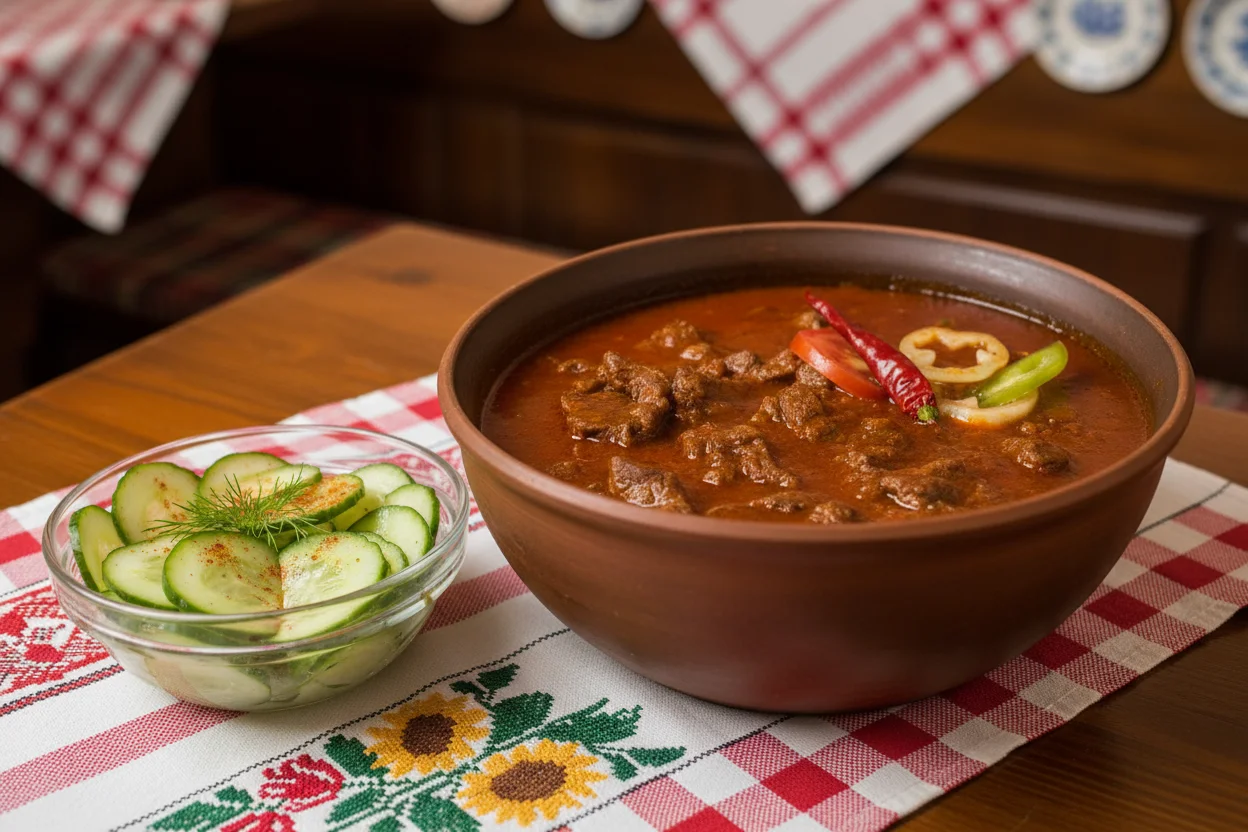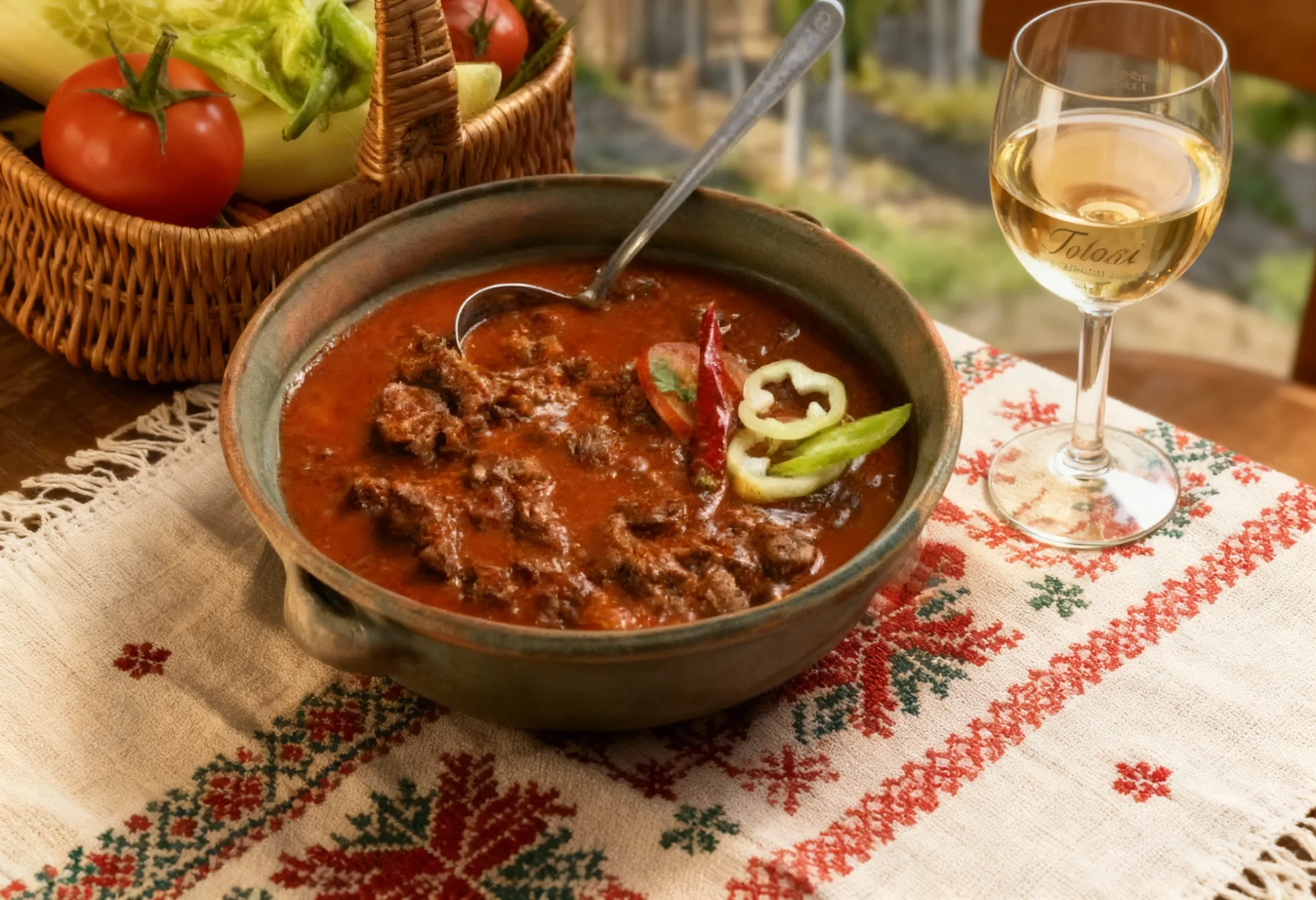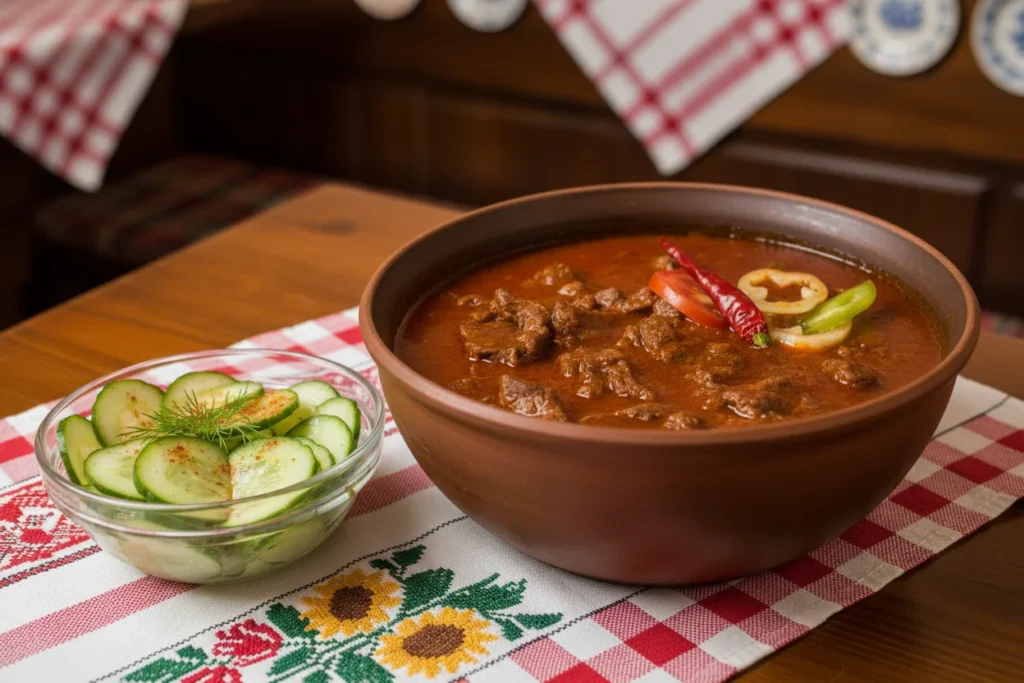Hungarian Spicy Tomato Beef Stew, or marhapörkölt, is a dish born from the Hungarian countryside — a bold, comforting blend of tender beef, rich paprika, and slow-simmered tomatoes. It’s a taste of home-cooked warmth and Old World tradition, reimagined with global flair at Rice Bowl Deluxe.
The History of Hungarian Spicy Tomato Beef Stew

Origins and Cultural Significance
The roots of Hungarian spicy tomato beef stew, known locally as pörkölt, can be traced back to the 9th century when the Hungarian tribes settled in the Carpathian Basin. This dish emerged as a hearty staple, embodying the essence of Hungarian agriculture—rich beef, vibrant vegetables, and spices. Its preparation reflects traditional communal cooking practices, often enjoyed at family gatherings and celebrations, symbolizing warmth and hospitality in Hungarian culture.
Evolution of the Recipe
Over the centuries, the recipe for Hungarian spicy tomato beef stew has evolved significantly, adapting to regional tastes and available ingredients. Historical influences, including Ottoman and Austrian cuisine, introduced new spices and techniques, enriching its flavor profile. Today, variations exist across Hungary, incorporating diverse ingredients like paprika, garlic, and even wine, each region boasting its unique twist while staying true to its comforting roots.
As influences from neighboring cultures merged with local practices, the recipe began to showcase the integration of ingredients such as sweet paprika from Szeged, known for its flavorful nuances. Kitchen experiments led to incorporating various vegetables, like bell peppers and carrots, while some cooks opt for herbs like thyme and bay leaves, enhancing complexity. Throughout its evolution, the dish has maintained its fundamental characteristics, becoming a beloved comfort food in households while adapting naturally to modern culinary trends without losing its identity.
Key Ingredients
Your choice of ingredients plays a vital role in achieving the authentic flavors of Hungarian spicy tomato beef stew. Each component, from the beef to the spices, contributes to the dish’s depth and complexity. Selecting high-quality products elevates your stew, ensuring a delightful dining experience that pays homage to its rich heritage.
Modern Adaptations
Modern adaptations of the stew focus on efficiency and accessibility without sacrificing taste. Utilizing pressure cookers or slow cookers, you can significantly reduce the cooking time while still achieving tender beef and a flavorful sauce. Additionally, creative tweaks such as incorporating different vegetables or herbs, or even using ground beef, can bring a fresh twist to this classic dish.
Exploring modern adaptations allows you to customize your stew to fit your taste preferences. For instance, swapping traditional lard for olive oil can make the dish lighter, while adding unique spices like cumin or smoked paprika can enhance the flavor profile. You might also consider using canned tomatoes for convenience or frozen vegetables for a quicker prep time. These innovations offer a versatile approach, letting you enjoy the essence of Hungarian spicy tomato beef stew tailored to your lifestyle.
Flavor Profiles
The complexity of Hungarian spicy tomato beef stew lies in its well-rounded flavor profiles that combine heat, richness, and aromatic depth. The fiery kick from paprika is complemented by the umami richness of slow-cooked beef and the natural sweetness from ripe tomatoes. This blend creates a warming, hearty essence that makes the dish a culinary staple. Each component enhances the others, forming a comforting dish where every bite delivers a burst of flavor that dances on your palate.
Balancing Spiciness and Richness
Your stewing method allows for a harmonious balance between the heat of spices and the deep richness of beef. Start with a base of onions and garlic sautéed until golden, then introduce paprika for heat. The slow cooking process melds these spicy notes with the beef’s natural flavors while the addition of tomatoes contributes sweetness, creating a layered taste experience that is warm rather than overwhelming.
The Role of Herbs and Seasonings
Incorporating herbs and seasonings elevates the stew to a new level, each adding their own character. Caraway seeds introduce an earthy note, while bay leaves infuse subtle complexity. As the stew simmers, any bitterness is mellowed, allowing flavors to develop fully. The signature touch of fresh parsley sprinkled just before serving brightens the dish, creating contrast and enhancing the overall taste.
Integrating herbs and seasonings can transform your dish from simple to extraordinary. Caraway seeds, with their distinct aroma, complement the rich meatiness, while bay leaves offer a fragrant backdrop. As the stew cooks, these elements become integral, allowing the flavors to marry and intensify. Fresh parsley at the end adds a vibrant touch, providing a refreshing contrast that rounds out the stew’s flavor profile. Mastery of these components not only deepens flavor but also showcases the dish’s rich culinary heritage.
Serving Suggestions
This hearty Hungarian spicy tomato beef stew can be a centerpiece at any meal, inviting you to explore various serving options that enhance its rich flavors.
Traditional Accompaniments
You’ll often find this stew paired with fluffy dumplings or fresh bread, perfect for sopping up the savory sauce. A side of pickled cucumbers or a simple green salad adds a refreshing crunch, balancing the dish’s warmth and depth.
Creative Twists
Add your personal touch by exploring creative twists on this classic stew. Incorporate unique ingredients like roasted red peppers for sweetness or a splash of red wine for additional depth. You might also experiment with different herbs and spices, such as fresh basil or a sprinkle of smoked paprika, to redefine the flavor profile.
For instance, consider adding chickpeas or lentils to introduce a new protein source and texture. A dollop of sour cream or Greek yogurt can also elevate the dish, adding a creamy contrast to the spicy tomato base. Serving over a bed of quinoa or rice instead of traditional dumplings can create a refreshing and nutritious adaptation, making the stew suitable for various dietary preferences. These ideas not only keep the spirit of the original recipe alive but also invite your creativity into the kitchen.
Nutritional Value
The Hungarian Spicy Tomato Beef Stew offers a well-rounded nutritional profile, rich in protein, vitamins, and minerals. Each serving provides a hearty dose of iron from the beef, while tomatoes contribute lycopene and necessary vitamins like C and A. The use of spices adds antioxidants, making this dish not only comforting but also nutritious.
Health Benefits of Key Ingredients
Each ingredient in the stew contributes unique health benefits. Beef is an excellent source of protein, supporting muscle growth and repair. Tomatoes provide antioxidants that may reduce the risk of chronic diseases, while spices like paprika and chili contain anti-inflammatory properties, boosting your immune system and enhancing overall health.
Tips for a Balanced Meal
Pair your stew with a variety of sides to create a balanced meal. Adding whole grains and fresh vegetables enhances the fiber and nutrient content, making your dish more satisfying. Consider serving it with brown rice or a side salad to complement the rich flavors of the stew.
- This approach will not only enhance the meal’s nutritional value but also create a well-rounded plate.
Incorporating diverse food groups ensures you receive a wide range of nutrients. Whole grains offer energy and fiber, while leafy greens provide vitamins and minerals. A dash of fermented vegetables can also enhance gut health. Keep your meal colorful and varied.
- This variety adds both visual appeal and vital nutrients to your dining experience.
Conclusion For Marhapörkölt – Hungarian Spicy Tomato Beef Stew




